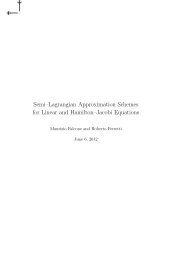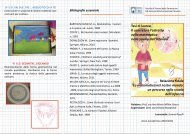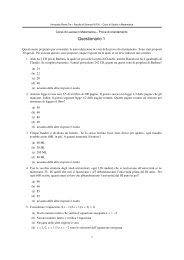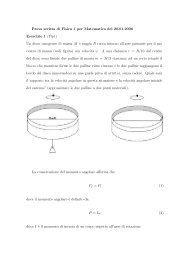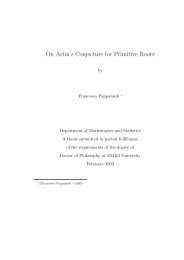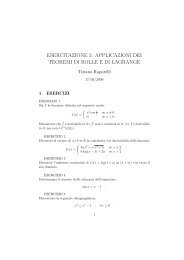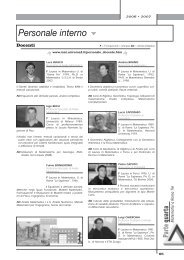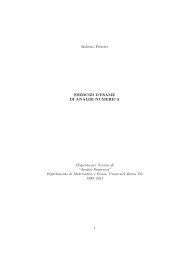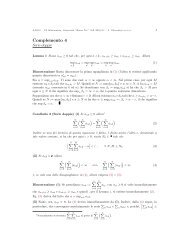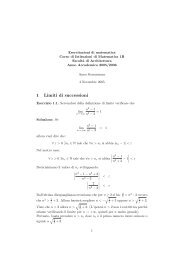Tutorato di Analisi 3 - Dipartimento di Matematica
Tutorato di Analisi 3 - Dipartimento di Matematica
Tutorato di Analisi 3 - Dipartimento di Matematica
You also want an ePaper? Increase the reach of your titles
YUMPU automatically turns print PDFs into web optimized ePapers that Google loves.
≤ 1 1<br />
è sufficiente prendere ρ =<br />
2 12 , e <strong>di</strong> conseguenza r = ρ 30 = 1<br />
360 .<br />
(c) Essendo √ 1 + x 1 − 1<br />
− e −g1(x1,x2) + cos(g 2 (x 1 , x 2 )) ≡ 0 ∀x ∈ B r ((0, 0)),<br />
1 + x 2 d ( √1<br />
+ x1 − 1 − e −g1(x1,x2) + cos(g 2 (x 1 , x 2 )))∣<br />
=<br />
dx 1 1 + x 2<br />
∣∣∣(x1,x 2)=(0,0)<br />
allora 0 =<br />
(<br />
1<br />
=<br />
2 √ + ∂g 1<br />
(x 1 , x 2 )e −g1(x1,x2) − ∂g 2<br />
(x 1 , x 2 ) sin(g 1 (x 1 , x 2 )))∣<br />
=<br />
1 + x 1 ∂x 1 ∂x 2<br />
∣∣∣(x1,x 2)=(0,0)<br />
= 1 2 + ∂g 1<br />
(0, 0) ⇒ ∂g 1<br />
(0, 0) = − 1 ∂x 1 ∂x 1 2 e 0 = d ( √1<br />
+ x1 − 1 −<br />
dx 2 1 + x 2<br />
)∣ (<br />
−e −g1(x1,x2) 1<br />
+ cos(g 2 (x 1 , x 2 ))<br />
=<br />
∣∣(x1,x 2)=(0,0) (1 + x 2 ) 2 +<br />
+ ∂g 1<br />
(x 1 , x 2 )e −g1(x1,x2) − ∂g 2<br />
(x 1 , x 2 ) sin(g 1 (x 1 , x 2 )))∣<br />
=<br />
∂x 2 ∂x 2<br />
∣∣∣(x1,x 2)=(0,0)<br />
= 1 + ∂g 2<br />
(0, 0) ⇒ ∂g 2<br />
(0, 0) = −1, analogamente log(cosh x 1 )−<br />
∂x 2 ∂x 2<br />
− sin(x 1x 2 )<br />
1 + g1 2(x 1, x 2 ) + arctan(g 2(x 1 , x 2 )) ≡ 0 ∀x ∈ B r ((0, 0)), dunque 0 =<br />
= d (<br />
log(cosh x 1 ) − sin(x 1x 2 )<br />
dx 1 1 + g1 2(x 1, x 2 ) + arctan(g 2(x 1 , x 2 )))∣<br />
=<br />
(<br />
∣∣∣(x1,x 2)=(0,0)<br />
= tanh x 1 − −2g 1(x 1 , x 2 ) ∂g1<br />
∂x 1<br />
(x 1 , x 2 ) sin(x 1 x 2 ) + ( 1 + g1(x 2 1 , x 2 ) ) (x 2 cos(x 1 x 2 ))<br />
(1 + g1 2(x 1, x 2 )) 2 +<br />
)∣<br />
∂g 2<br />
∂x<br />
+ 1<br />
(x 1 , x 2 )<br />
1 + g2 2(x =<br />
1, x 2 )<br />
∣∣∣∣(x1,x ∂g 2<br />
(0, 0) ⇒ ∂g 2<br />
(0, 0) = 0 e 0 =<br />
∂x 1 ∂x 1<br />
2)=(0,0)<br />
= d (<br />
log(cosh x 1 ) − sin(x 1x 2 )<br />
dx 2 1 + g1 2(x 1, x 2 ) + arctan(g 2(x 1 , x 2 )))∣<br />
=<br />
(<br />
∣∣∣(x1,x 2)=(0,0)<br />
= − −2g 1(x 1 , x 2 ) ∂g1<br />
∂x 2<br />
(x 1 , x 2 ) sin(x 1 x 2 ) + ( 1 + g1(x 2 1 , x 2 ) ) (x 1 cos(x 1 x 2 ))<br />
(1 + g1 2(x 1, x 2 )) 2 +<br />
)∣<br />
∂g 2<br />
∂x<br />
+ 2<br />
(x 1 , x 2 )<br />
1 + g2 2(x =<br />
1, x 2 )<br />
∣∣∣∣(x1,x ∂g 2<br />
(0, 0) ⇒ ∂g 2<br />
(0, 0) = 0; quin<strong>di</strong>,<br />
∂x 2 ∂x 2<br />
〈( 2)=(0,0)<br />
∂g1<br />
g 1 (x 1 , x 2 ) = g 1 (0, 0) + (0, 0), ∂g ) 〉<br />
1<br />
(0, 0) , (x 1 , x 2 ) +<br />
∂x 1 ∂x<br />
(√ )<br />
2<br />
+o x 2 1 + x2 2 = − x (√ )<br />
1<br />
2 − x 2 + o x 2 1 + x2 2 e g 2 (x 1 , x 2 ) = g 2 (0, 0)+<br />
〈( ∂g2<br />
+ (0, 0), ∂g ) 〉 (√ ) (√ )<br />
2<br />
(0, 0) , (x 1 , x 2 ) + o x 2 1<br />
∂x 1 ∂x + x2 2 = o x 2 1 + x2 2<br />
2<br />
(<br />
)<br />
4. F (x, y) = sin(xy) + x cos y, e x+y 1<br />
−<br />
1 + x 2 + y 2 .<br />
(a) F è <strong>di</strong> classe C 1 ( in un intorno dell’origine con F (0, 0) = (0,)∣ 0), inoltre<br />
∂F<br />
y cos(xy) + cos y x cos(xy) − x sin y ∣∣∣∣(x,y)=(0,0)<br />
∂(x, y) (0, 0) = e x+y 2x<br />
−<br />
e x+y 2y<br />
=<br />
−<br />
(1+x 2+y 2) 2<br />
(1+x 2 +y 2 ) 2<br />
( )<br />
( ) −1 ( )<br />
1 0<br />
∂F<br />
1 0<br />
= è invertibile (con T =<br />
1 1<br />
∂(x, y) (0, 0) =<br />
),<br />
−1 1



